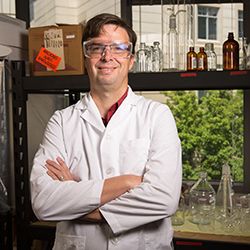Jamie Hestekin
 Professor, Ralph E. Martin Professorship in Chemical Engineering
Professor, Ralph E. Martin Professorship in Chemical Engineering
Ph.D in Chemical Engineering, University of Kentucky
B.S. Chemical Engineering, University of Minnesota, Duluth
jhesteki@uark.edu
In his own words ...
My favorite thing about working with Honors College students is ... they have so much energy and excitement for research!
When I want to relax, I ... spend time with my family. I have a five-year-old daughter, and so I’m doing all sorts of five-year-old things. Last weekend we made about 20 bracelets from beads. We also like to swim in our backyard pool.
What are the pros and cons of being married to another chemical engineering professor? (Christa Hestekin is also a faculty member at the UA.) The pro is that you always have someone to talk to about your job, and the con is that you always have someone to talk to about your job. Work tends to permeate everything. We have to make an effort not to talk about our research.
I got interested in chemical engineering because ... I wanted to save the world. When I was young, I’d watch the news and see the problems with pollution. Chemical engineering can clean up pollution. That’s a good thing to do. Membranes can stop pollution before it happens, and that’s a good thing to do, too.
About his research:
Jamie Hestekin’s work with charged membrane separations impacts technologies as diverse
as biofuels, artificial lungs and hydraulic fracturing. The membranes function as
filters, separating gasses, molecules or other substances from their host materials.
The hollow fiber membrane used in the artificial lung removes carbon dioxide and oxygenates
blood, for example.
Hestekin enjoys collaborating with industrial partners, energized by the cross-fertilization
not found in solo lab research. “If you just get people talking, you come up with
better ideas,” he said. He applies the same approach to his work with undergraduates.
“Honors College students are very bright,” he said. “I throw them in the deep end
without a life jacket and see what they can figure out. Some projects turn into extremely
big deals. Some don’t turn out so well, but they’re still experiences.”
Goldwater Scholar Nikki Lorenz used a double fermentation hydrolysis process and innovative
separations to produce butanol, a type of biofuel, from various organic materials.
Her work contributed to two published articles and continues to interest researchers.
Another biofuel project involves algae, which grows quickly but is very wet. Hestekin’s
students are working to separate the valuable lipids from the water and address other
issues that hinder large-scale production. In 2012, Hestekin and a team of undergraduates
were named co-winners of Planet Forward’s Innovator of the Year for the algae-to-butanol project in a contest that aired on public television stations
nationwide.
Another area of research focuses on developing technologies to make hydraulic fracturing
more efficient. It takes 1 to 5 million gallons of water to frack a well, Hestekin
said. Recycling that water or using it to generate energy to power the fracking operation
are ways to mitigate the environmental effects. Hailey Dunsworth, another Goldwater
Scholar, used a form of reverse electrodialysis to recover energy from water used
in fracking. Her work was instrumental for a patent application filed for the process.
Hestekin has published papers with 13 undergraduates. His students have won two EPA
Greater Research Opportunity Fellowships, as well as the two Goldwater Fellowships
and three Goldwater honorable mentions.